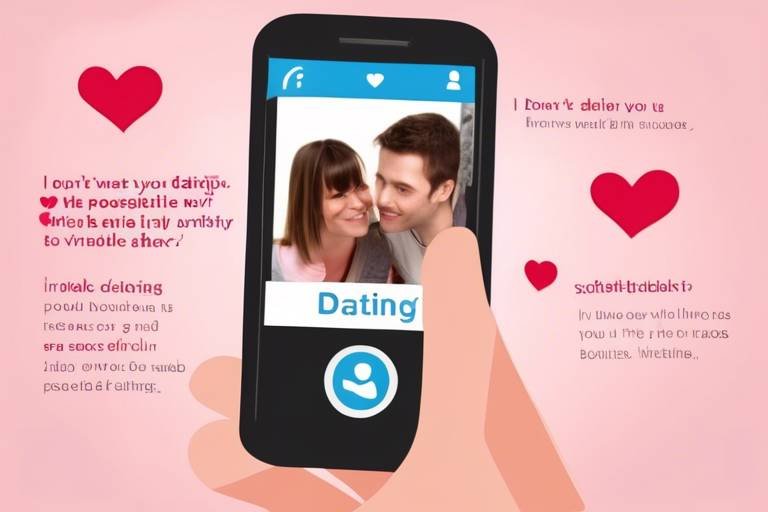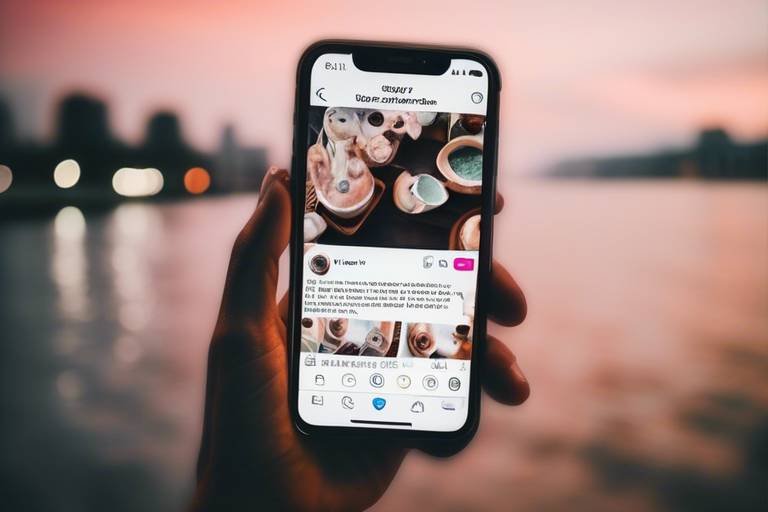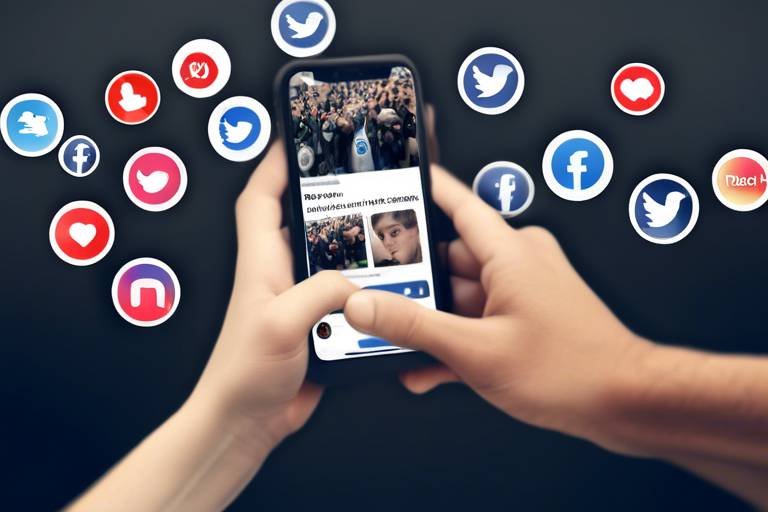Securing Your Personal Data from Facebook
In today's digital age, where sharing is the norm and social media platforms like Facebook dominate our online interactions, securing your personal data has never been more critical. With billions of users worldwide, Facebook is a treasure trove of personal information, making it a prime target for cybercriminals. But fear not! By implementing a few effective strategies, you can protect your personal information and maintain your privacy while enjoying the social aspects of the platform. So, let’s dive into some practical steps that will help you navigate the often murky waters of online security.
First things first, let’s talk about Facebook's privacy settings. These settings are your first line of defense against unwanted access to your personal information. Familiarizing yourself with these options is crucial, as they allow you to control who sees what on your profile. Imagine you’re in a crowded room; you wouldn’t want everyone to overhear your private conversations, right? Similarly, you need to adjust your privacy settings to keep your personal details safe from prying eyes.
To access these settings, simply navigate to the 'Settings & Privacy' tab on your Facebook profile. Here, you can customize who can see your posts, who can send you friend requests, and even who can look you up using your email or phone number. Remember, the more you know about these settings, the better you can protect yourself. It's like having a security system for your online life!
Now, let’s tackle the ever-present threat of phishing scams. These deceptive tactics are designed to trick you into revealing your personal information, and they can be particularly prevalent on social media platforms. Phishing can take many forms, from fake messages that appear to come from Facebook itself to malicious links that lead to fraudulent websites. Recognizing these scams is essential to safeguarding your data.
Cybercriminals employ various methods to execute phishing attacks, and being aware of these techniques is your best defense. Some common tactics include:
- Fake Links: Links that seem legitimate but lead to malicious sites.
- Misleading Messages: Messages that create a sense of urgency, prompting you to act without thinking.
- Impersonation: Accounts that mimic Facebook's official pages to deceive users.
Always remember, if something feels off, it probably is! Trust your instincts and take a moment to verify before clicking on any links.
Spotting suspicious links can be a game-changer in avoiding phishing attempts. Look for red flags such as:
- Unusual web addresses that don’t match the official Facebook URL.
- Links shortened by URL shorteners, which can hide their true destination.
- Typos or strange characters in the link itself.
If you encounter any of these warning signs, steer clear of the link and report it if necessary.
Taking action against phishing attempts not only protects you but also helps the Facebook community. If you come across a suspicious message or link, report it! Facebook provides an easy way to report phishing attempts directly through their platform. By doing so, you contribute to a safer online environment for everyone.
Your password is your first line of defense against unauthorized access to your account. A weak password is like leaving your front door wide open! It’s essential to create complex passwords that are difficult for others to guess. Aim for a mix of letters, numbers, and symbols, and avoid using easily accessible information like your birthday or pet's name. A good rule of thumb is to use at least 12 characters.
Consider using a password manager to help you generate and store strong passwords securely. This way, you won’t have to remember every password, and you can ensure they are all unique and complex.
Implementing two-factor authentication (2FA) is another powerful way to secure your Facebook account. This feature adds an extra layer of security by requiring not just your password but also a second form of verification, such as a code sent to your phone. It’s like having a double lock on your front door; even if someone has your key (password), they still can’t get in without the second key (the verification code).
When setting up 2FA, you’ll have various methods to choose from, including:
- SMS Codes: A text message with a verification code.
- Authentication Apps: Apps like Google Authenticator generate codes for you.
- Hardware Tokens: Physical devices that generate codes.
Understanding these options allows you to select the method that best fits your needs and offers the highest security level.
Enabling two-factor authentication provides numerous benefits, including enhanced security and peace of mind. With 2FA, even if someone manages to obtain your password, they won’t be able to access your account without that second verification step. It’s a simple yet effective way to significantly reduce the risk of unauthorized access to your Facebook account.
Q: How often should I change my Facebook password?
A: It’s recommended to change your password every 3 to 6 months, or immediately if you suspect any unauthorized access.
Q: What should I do if I think I’ve fallen for a phishing scam?
A: Change your password immediately and enable two-factor authentication. Report the scam to Facebook and monitor your account for any unusual activity.
Q: Can I use the same password for multiple accounts?
A: It’s not advisable. Using unique passwords for each account minimizes the risk if one account is compromised.

Understanding Facebook's Privacy Settings
This article explores effective strategies to protect your personal information on Facebook, ensuring your privacy and security in the digital landscape. Learn how to navigate settings and enhance your online presence safely.
When it comes to safeguarding your personal data on Facebook, understanding the platform's privacy settings is absolutely essential. Think of these settings as your personal fortress—once you know how to fortify it, you can keep your information safe from prying eyes. Facebook provides a range of options that allow you to control who sees your posts, who can send you friend requests, and even who can look you up using your email address or phone number. Familiarizing yourself with these settings is like learning the map of your own home; it helps you navigate your privacy with confidence.
To access your privacy settings, simply click on the small triangle in the top right corner of your Facebook page and select Settings & Privacy, followed by Settings. Here, you'll find a plethora of options under the Privacy tab that you can customize. It’s not just about turning things on or off; it’s about making informed choices that reflect how you want to interact with the world. For instance, you can choose to limit your audience for future posts, ensuring that only your friends—or even just a select group—can see what you share.
Moreover, you can also manage friend requests and set limits on who can find you through search engines. This is a crucial step in maintaining your digital footprint. Imagine walking through a crowded market; you wouldn’t want strangers to be able to easily find you, right? Similarly, adjusting these settings can help you control your visibility on Facebook. Here are some key privacy settings to consider:
- Who can see your future posts? Choose between Public, Friends, or Only Me.
- Who can send you friend requests? You can limit this to Friends of Friends or keep it open to everyone.
- Who can look you up using your email address or phone number? Set this to Friends or Only Me for added privacy.
It’s also wise to review your past posts and adjust their audience settings. You might have shared something years ago that you no longer want to be public. Facebook allows you to go back and change who can see those posts, giving you the power to clean up your digital history. Additionally, consider reviewing your tagging settings to control who can tag you in posts and photos, which can further enhance your privacy.
As you navigate through these settings, you might feel overwhelmed by the amount of information available. Don’t worry! Facebook offers a helpful Privacy Checkup tool that guides you through the most important settings step by step. It’s like having a personal assistant that helps you secure your space without the hassle. Remember, your privacy is in your hands, and by taking the time to understand these settings, you're not just protecting yourself; you're also taking a stand for your right to privacy in this digital age.
Phishing scams are prevalent on social media platforms. This section discusses how to identify and avoid these deceptive tactics, ensuring that you don't fall victim to malicious attempts to steal your data.
Explore the various methods used by cybercriminals to execute phishing attacks, including fake links and misleading messages. Awareness of these techniques is essential for safeguarding your personal information.
Learn how to spot suspicious links that could lead to phishing sites. Understanding the characteristics of these links can help you avoid potential threats to your data security.
Discover the steps to report phishing attempts on Facebook. Taking action against these scams not only protects you but also helps the community by alerting Facebook to potential threats.
A strong password is your first line of defense against unauthorized access. This section emphasizes the importance of password complexity and offers tips for creating secure passwords for your Facebook account.
Implementing two-factor authentication adds an extra layer of security to your Facebook account. This section explains how to set it up and the benefits it provides in protecting your personal data.
Explore the various authentication methods available, such as SMS codes and authentication apps. Understanding these options allows you to select the most secure method for your needs.
Learn about the advantages of enabling two-factor authentication, including enhanced security and peace of mind. This additional step significantly reduces the risk of unauthorized access to your account.
Q: How can I make my Facebook account more private?
A: You can adjust your privacy settings, limit who can see your posts, and review past posts to ensure only the right people have access to your information.
Q: What should I do if I receive a suspicious message on Facebook?
A: Do not click on any links or provide personal information. Report the message to Facebook and delete it.
Q: Is two-factor authentication really necessary?
A: Yes! It adds an extra layer of security, making it much harder for unauthorized users to access your account.

Recognizing Phishing Scams
In today's digital age, where our lives are intertwined with social media, recognizing phishing scams has become more crucial than ever. Phishing scams are deceptive tactics used by cybercriminals to trick you into revealing your personal information, such as passwords, credit card numbers, and other sensitive data. These scams can come in various forms, including emails, messages, and even fake websites that look remarkably similar to legitimate sites. The key to staying safe is to be vigilant and informed. So, how can you spot these scams before they ensnare you?
First and foremost, always be skeptical of unsolicited messages or friend requests, especially those that urge you to click on links or provide personal information. A common tactic is to create a sense of urgency; for example, they might say your account will be suspended unless you verify your information immediately. This is a classic red flag! If something feels off, it probably is.
Additionally, it's vital to familiarize yourself with the common techniques used in phishing scams. Here are a few to watch out for:
- Fake Links: Often, the URLs provided in phishing messages will appear legitimate at first glance but will lead to malicious sites. Always hover over links to see the actual URL before clicking.
- Misleading Messages: Phishing attempts can come in the form of messages that claim to be from Facebook or other trusted entities, asking you to log in to verify your account. These messages may contain spelling errors or unusual phrasing.
- Attachments: Be wary of unexpected attachments, even if they come from someone you know. Cybercriminals can compromise accounts and send out phishing messages to your contacts.
Recognizing these tactics is your first line of defense. But what if you encounter a suspicious link? Understanding how to identify suspicious links can significantly enhance your security. Look for URLs that don't match the official site or have strange characters. For instance, a legitimate Facebook link should always start with https://www.facebook.com. If you see anything else, it's best to avoid it.
Lastly, if you do happen to encounter a phishing attempt, reporting it is crucial. Facebook provides tools to report suspicious messages and links. By taking action, you're not only protecting yourself but also helping to keep the community safe. The more we report, the harder it becomes for these scammers to operate. Remember, awareness is key in the fight against phishing scams!
Q: What should I do if I clicked on a phishing link?
A: If you clicked on a phishing link, immediately change your password and enable two-factor authentication. Monitor your account for any suspicious activity.
Q: How can I report a phishing attempt on Facebook?
A: To report a phishing attempt, go to the message or post, click on the three dots in the upper right corner, and select "Report." Follow the prompts to complete your report.
Q: Are phishing scams only found on Facebook?
A: No, phishing scams can occur on any platform, including email, Twitter, Instagram, and more. Always be cautious when sharing personal information online.

Common Phishing Techniques
Phishing scams have become a pervasive issue in our digital age, especially on platforms like Facebook where personal information is shared freely. It's alarming how cybercriminals have honed their skills to devise clever tactics that can trick even the most vigilant users. Understanding these common phishing techniques is crucial for anyone looking to safeguard their personal data. By familiarizing yourself with these methods, you can better protect yourself from falling prey to these deceitful schemes.
One of the most prevalent techniques involves fake links. These are often disguised as legitimate URLs that might lead to a familiar-looking login page. For instance, you might receive a message claiming to be from Facebook, urging you to click on a link to verify your account or recover a password. Once you click on the link, you could be redirected to a phishing site designed to steal your credentials. Always hover over links before clicking to see the actual URL; if it looks suspicious or doesn't match the official Facebook domain, it's best to steer clear.
Another common tactic is the use of misleading messages. Cybercriminals often craft messages that appear to come from friends or trusted sources. They may claim that you've been tagged in a photo or that there's a new message waiting for you. These messages can create a false sense of urgency, prompting you to click on a link without thinking twice. It's important to verify such messages directly with the sender, especially if they contain links or requests for personal information.
Moreover, phishing attempts can also manifest through social engineering. This technique involves manipulating individuals into divulging confidential information. For example, a scammer might impersonate a Facebook employee, claiming they need to verify your identity due to suspicious activity on your account. They may ask for your password or other sensitive information, exploiting your trust. Always remember that legitimate companies will never ask for your password via email or direct message.
To summarize, here are some key phishing techniques to watch out for:
- Fake Links: Always check the URL before clicking.
- Misleading Messages: Verify unexpected messages with the sender.
- Social Engineering: Be cautious of unsolicited requests for personal information.
By being aware of these common phishing techniques, you can take proactive steps to protect your personal information. Always trust your instincts; if something feels off, it probably is. Stay informed, stay alert, and keep your data safe!
Q: What should I do if I suspect I've fallen for a phishing scam?
A: If you think you've been targeted, immediately change your password and enable two-factor authentication. Report the phishing attempt to Facebook and monitor your account for any unusual activity.
Q: Are phishing scams only conducted via email?
A: No, phishing scams can occur through various channels, including social media platforms like Facebook, SMS, and even phone calls. Always be cautious of unsolicited communications.
Q: How can I educate myself further about phishing scams?
A: Consider following cybersecurity blogs, enrolling in online courses, or checking resources from reputable organizations that focus on internet safety and security.

Identifying Suspicious Links
When browsing Facebook or any other social media platform, it's crucial to remain vigilant about the links you encounter. Suspicious links can lead to phishing sites designed to steal your personal information. So, how do you differentiate between a harmless link and a potential threat? Here are some key indicators to look out for:
- Check the URL: Before clicking, hover over the link to see the actual URL. If it seems off or contains misspellings, such as "facebo0k.com" instead of "facebook.com," proceed with caution.
- Look for HTTPS: Secure websites begin with "https://" rather than "http://". The 's' signifies that the site is using a secure connection, which is crucial for protecting your data.
- Be wary of shortened URLs: Services like bit.ly or tinyurl can conceal the actual destination of a link. Use a URL expander tool to see where a shortened link leads before clicking.
- Trust your instincts: If a link seems too good to be true, it probably is. Offers that promise outrageous rewards or urgent notifications are often traps.
In addition to these tips, always consider the context in which a link is shared. If a friend sends you a link that seems out of character or unsolicited, reach out to them directly to verify its authenticity. Cybercriminals often hijack accounts and send phishing links to the victim's friends, making it essential to confirm before clicking.
Furthermore, keep an eye out for pop-up windows that ask for personal information after clicking a link. Legitimate sites typically do not request sensitive data in this manner. If you encounter such a prompt, close the window immediately and do not provide any information.
By staying alert and informed about the characteristics of suspicious links, you can significantly reduce the risk of falling victim to phishing scams. Remember, your online safety is in your hands, and a little skepticism can go a long way in protecting your personal data.
Q: What should I do if I accidentally clicked on a suspicious link?
A: If you clicked on a suspicious link, immediately disconnect from the internet, change your passwords, and run a security scan on your device. Monitor your accounts for unusual activity.
Q: Can I report suspicious links on Facebook?
A: Yes! If you encounter a suspicious link, you can report it to Facebook by clicking on the three dots next to the post and selecting "Report." This helps keep the platform safer for everyone.
Q: Are there tools available to help identify phishing links?
A: Absolutely! There are several browser extensions and online tools designed to check the safety of links before you click. Consider using them for an added layer of protection.

Reporting Phishing Attempts
It’s a jungle out there in the digital world, and phishing attempts are like the sneaky predators lurking in the shadows, waiting to pounce on unsuspecting victims. So, what can you do if you encounter one of these deceptive traps? Reporting phishing attempts on Facebook is not just a good idea; it’s a crucial step in keeping your online community safe. When you report suspicious activity, you’re not only protecting yourself but also helping to shield others from falling prey to these scams.
First things first, if you believe you've encountered a phishing attempt, whether it’s a message, a post, or even a friend request, it’s essential to act quickly. Facebook has made it relatively straightforward to report these incidents. Here’s how you can do it:
- Identify the Phishing Attempt: Look for signs such as strange messages, requests for personal information, or links that seem out of place.
- Access Reporting Options: Click on the three dots (•••) located next to the post or message that you deem suspicious.
- Select 'Report': Choose the option that best describes the issue, such as “It’s a scam” or “It’s a fake account.”
- Follow the Prompts: Facebook will guide you through the reporting process, which may include providing additional details about the incident.
Once you've reported the phishing attempt, it’s also a good practice to inform your friends and family about the scam. Share your experience and help them recognize the signs of phishing. You could even create a post on your timeline or send a message to your close contacts. Remember, awareness is the first line of defense!
Moreover, if you’ve clicked on a suspicious link or provided any personal information, be sure to take immediate action to secure your account. Change your password, enable two-factor authentication, and monitor your account for any unusual activity. The quicker you act, the better your chances of minimizing any potential damage.
In conclusion, reporting phishing attempts is a vital part of maintaining a safe online environment. By taking proactive steps, you contribute to a collective effort that keeps Facebook a secure platform for everyone. So, the next time you spot a phishing attempt, don’t hesitate—report it and help make the digital world a safer place!

Creating Strong Passwords
In today's digital age, where our lives are intertwined with social media platforms like Facebook, creating strong passwords is not just a good practice; it's essential. Think of your password as the key to your personal vault. If your key is weak, anyone can waltz right in and steal your treasures. So, how do you craft a password that stands strong against potential intruders? First, it’s important to understand that a strong password is one that is complex and unique. Aim for a combination of uppercase letters, lowercase letters, numbers, and special characters. A password like G7!dF@9qZ is far more secure than something like password123.
Moreover, length matters! The longer your password, the harder it is for hackers to crack it. A good rule of thumb is to aim for at least 12 to 16 characters. To help you visualize the difference, consider this table:
| Password Example | Strength Level |
|---|---|
| 123456 | Weak |
| password | Weak |
| G7!dF@9qZ | Strong |
| Th1s1s@Str0ngP@ssw0rd! | Very Strong |
Another effective strategy is to use a passphrase—a series of random words or a sentence that’s easy for you to remember but difficult for others to guess. For example, “BlueSky!Dancing@Moonlight” is both memorable and secure. Additionally, avoid using personal information like birthdays or names, as these can be easily guessed or found through social media stalking.
Finally, consider utilizing a password manager. These handy tools can generate and store complex passwords for you, so you don’t have to remember every single one. It’s like having a personal bodyguard for your passwords. Just remember to secure your password manager with a strong master password, as that will be the key to all your other keys!
In conclusion, creating strong passwords is your first line of defense against unauthorized access to your Facebook account. By following these guidelines, you can significantly enhance your online security and protect your personal information from prying eyes.
- What makes a password strong? A strong password includes a mix of uppercase letters, lowercase letters, numbers, and special characters, and is at least 12 characters long.
- How often should I change my password? It's a good idea to change your password every 3 to 6 months or immediately if you suspect any suspicious activity.
- Can I use the same password across multiple accounts? It's best to avoid using the same password for multiple accounts to minimize risk. Consider using a password manager to keep track of different passwords.

Two-Factor Authentication
In today's digital world, where our lives are intricately woven into the fabric of social media, securing your online presence has never been more critical. One of the most effective ways to bolster your Facebook security is by implementing two-factor authentication (2FA). This feature acts like a fortified gate, ensuring that even if someone gets hold of your password, they still can't waltz into your account without the second key. But what exactly is 2FA, and how can you set it up? Let's dive into the details!
Two-factor authentication is a security process that requires not just a password and username but also something that only the user has on them—like a physical device or a unique code sent to their phone. This two-step verification process adds an extra layer of security, making it significantly harder for unauthorized users to access your account. It’s like having a second lock on your door; even if someone manages to pick the first one, they still face a formidable barrier!
Setting up two-factor authentication on Facebook is a straightforward process. Here’s a quick rundown of how to do it:
- Go to your Facebook account settings.
- Select the "Security and Login" option.
- Look for the "Two-Factor Authentication" section and click "Edit."
- Choose your preferred method of receiving codes, such as via SMS or an authentication app.
- Follow the prompts to complete the setup.
Once you have 2FA enabled, you’ll receive a unique code each time you log in from an unrecognized device or browser. This means that even if someone manages to steal your password, they won’t be able to access your account without that additional code. It’s a simple yet powerful tool to keep your personal data safe!
When setting up two-factor authentication, you’ll typically have a couple of options for how you receive your authentication codes. The most common methods include:
- SMS Codes: A text message is sent to your registered phone number with a unique code each time you log in.
- Authentication Apps: Apps like Google Authenticator or Authy generate time-sensitive codes that you can use instead of receiving a text.
While both methods are effective, using an authentication app is generally considered more secure since SMS can be intercepted. Think of it like using a high-tech security system versus a traditional lock; the former is much harder to bypass!
Enabling two-factor authentication on your Facebook account comes with numerous benefits:
- Enhanced Security: With an additional layer of security, your account is much less likely to be hacked.
- Peace of Mind: Knowing that your information is protected allows you to enjoy your Facebook experience without constant worry.
- Community Protection: By securing your account, you not only protect yourself but also help keep the Facebook community safer from potential threats.
In conclusion, two-factor authentication is a vital step in securing your Facebook account. It’s a simple process that can dramatically reduce the risk of unauthorized access. So why not take that extra step to protect your personal information? Remember, in the vast digital landscape, being proactive about your security is the best defense!
Q: What happens if I lose my phone with two-factor authentication enabled?
A: If you lose your phone, you can use backup codes that Facebook provides during the 2FA setup process. Make sure to store these codes in a safe place!
Q: Can I turn off two-factor authentication later?
A: Yes, you can disable two-factor authentication at any time through your account settings, but it’s highly recommended to keep it enabled for added security.
Q: Is two-factor authentication available for all types of Facebook accounts?
A: Yes, two-factor authentication is available for both personal and business accounts on Facebook.

Choosing Authentication Methods
When it comes to securing your Facebook account, choosing the right authentication method is paramount. With cyber threats lurking around every corner of the internet, you want to ensure that your personal data is well-protected. Facebook offers several methods for two-factor authentication (2FA), each with its own pros and cons. So, how do you decide which one is best for you?
First off, let’s talk about the most common method: SMS codes. This method sends a unique code to your mobile phone every time you log in from an unrecognized device. It’s straightforward and convenient, especially if you always have your phone nearby. However, there are some drawbacks. If your phone gets lost or stolen, or if you fall victim to SIM swapping, hackers could potentially gain access to your account. Therefore, while SMS codes are better than having no 2FA at all, they might not be the most secure option.
Next, we have authentication apps, like Google Authenticator or Authy. These apps generate time-sensitive codes that you can use for logging in. They are generally considered more secure than SMS codes because they don’t rely on your phone number, making them less vulnerable to attacks. Plus, you don’t have to worry about receiving codes while you're on the go. Just open the app, and you’ll have your code in seconds. However, it’s important to keep in mind that if you lose your phone, you’ll need to go through a recovery process to regain access to your accounts.
Another option is hardware tokens. These are small physical devices that generate login codes. They are incredibly secure because they are not connected to the internet, making it nearly impossible for hackers to intercept the codes. However, they can be a bit cumbersome to carry around. If you forget it at home, you might find yourself locked out of your account. It’s a trade-off between security and convenience.
Lastly, some users opt for biometric authentication, like fingerprint or facial recognition. This method is gaining popularity due to its ease of use and high security. You simply use your fingerprint or face to log in, which is something you always have with you—yourself! However, biometric data can be sensitive, and if compromised, it can lead to serious issues. Therefore, it’s crucial to weigh the risks before opting for this method.
In summary, the best authentication method for you largely depends on your personal preferences and lifestyle. Here’s a quick comparison in the table below to help you make your decision:
| Method | Security Level | Convenience | Drawbacks |
|---|---|---|---|
| SMS Codes | Moderate | High | Vulnerable to SIM swapping |
| Authentication Apps | High | Moderate | Phone loss can complicate access |
| Hardware Tokens | Very High | Low | Can be forgotten or lost |
| Biometric Authentication | High | Very High | Potential privacy concerns |
Ultimately, the best strategy is to combine methods where possible. For example, you could use an authentication app along with a strong password to create a robust security framework for your Facebook account. Remember, in the digital landscape, vigilance is your best friend. The more layers of security you have, the harder it becomes for cybercriminals to breach your defenses.
- What is two-factor authentication? Two-factor authentication (2FA) is an extra layer of security that requires not only a password and username but also something that only the user has on them, such as a physical token or a mobile device.
- Can I use multiple authentication methods on Facebook? Yes, Facebook allows you to set up multiple authentication methods for added security.
- What should I do if I lose my phone with my authentication app? If you lose your phone, you can recover your account by using backup codes provided when you set up 2FA or by going through Facebook's recovery process.

Benefits of Two-Factor Authentication
In today's digital world, where cyber threats lurk around every corner, two-factor authentication (2FA) has emerged as a formidable ally in the battle to protect your personal data on Facebook. By requiring not just a password but also a second form of verification, 2FA significantly enhances the security of your account. Imagine your Facebook account as a treasure chest; your password is the key, but two-factor authentication adds a robust lock that makes it nearly impossible for thieves to break in.
One of the most compelling benefits of two-factor authentication is the added layer of security. Even if a hacker manages to steal your password, they would still need that second verification step to gain access. This could be a code sent to your mobile phone or an authentication app. The extra effort required means that even the most determined cybercriminals will have a tougher time accessing your account. In fact, studies show that accounts with 2FA are 99% less likely to be compromised.
Moreover, enabling two-factor authentication can provide you with peace of mind. Knowing that your account is fortified against unauthorized access allows you to browse and interact on Facebook without the constant worry of being hacked. It’s like having a security guard watching over your digital life, giving you the freedom to connect with friends and family without fear.
Another significant advantage is the versatility of authentication methods. Facebook offers various options for the second factor, allowing you to choose the method that best fits your lifestyle. Whether you prefer receiving a text message, using an authentication app, or even a hardware key, you have the flexibility to select what works for you. This adaptability is crucial in ensuring that you don’t feel burdened by the security measures you put in place.
To illustrate the benefits further, let’s take a look at a simple comparison:
| Without 2FA | With 2FA |
|---|---|
| Single point of entry (password only) | Two points of verification (password + second factor) |
| Higher risk of unauthorized access | Significantly reduced risk of breaches |
| Feeling of vulnerability | Enhanced confidence in account security |
| Less control over account security | Greater control with customizable authentication methods |
In summary, the benefits of two-factor authentication are clear and compelling. By implementing this additional security measure, you not only protect your Facebook account from potential threats but also gain a sense of control and confidence in your online interactions. So, why wait? Take the step today to enable two-factor authentication and safeguard your personal data like never before!
- What is two-factor authentication? Two-factor authentication is a security process that requires two different forms of identification to access your account, typically a password and a secondary verification method.
- How do I enable two-factor authentication on Facebook? You can enable 2FA in your Facebook account settings under the security section. Follow the prompts to set up your preferred authentication method.
- What happens if I lose my phone with the authentication app? Most authentication apps provide backup codes that you can use to access your account if you lose your phone. Always keep these codes in a safe place!
- Is two-factor authentication really necessary? While it may seem like an extra step, the added security it provides is invaluable in protecting your personal information from unauthorized access.
Frequently Asked Questions
- How can I adjust my privacy settings on Facebook?
To adjust your privacy settings on Facebook, go to your account settings and navigate to the "Privacy" section. Here, you can control who can see your posts, who can send you friend requests, and how your information is shared with others. It’s essential to regularly review these settings to ensure your personal information is protected.
- What should I do if I receive a suspicious message on Facebook?
If you receive a suspicious message, do not click on any links or provide any personal information. Instead, report the message to Facebook. You can do this by clicking on the three dots in the corner of the message and selecting "Report." This helps keep the platform safe for everyone.
- What are some common signs of phishing attempts?
Common signs of phishing attempts include messages that create a sense of urgency, contain spelling or grammatical errors, or ask for personal information. Additionally, be wary of links that seem unusual or lead to unfamiliar websites. Always double-check the URL before clicking.
- How can I create a strong password for my Facebook account?
To create a strong password, use a mix of uppercase and lowercase letters, numbers, and special characters. Aim for at least 12 characters and avoid using easily guessed information like birthdays or names. Consider using a password manager to keep track of your passwords securely.
- What is two-factor authentication and how do I set it up?
Two-factor authentication (2FA) is an extra layer of security that requires not just your password but also a second form of verification, such as a code sent to your phone. To set it up, go to your security settings on Facebook and follow the prompts to enable 2FA. This significantly enhances your account security.
- What are the benefits of using two-factor authentication?
The main benefit of two-factor authentication is increased security. Even if someone manages to get your password, they won't be able to access your account without the second verification step. This gives you peace of mind knowing your personal data is better protected.
- How can I report phishing attempts on Facebook?
To report phishing attempts, click on the three dots next to the message or post and select "Report." You can then choose the option that best describes the issue, such as "Scams and Fraud." Reporting these attempts helps Facebook take action against malicious users.



















